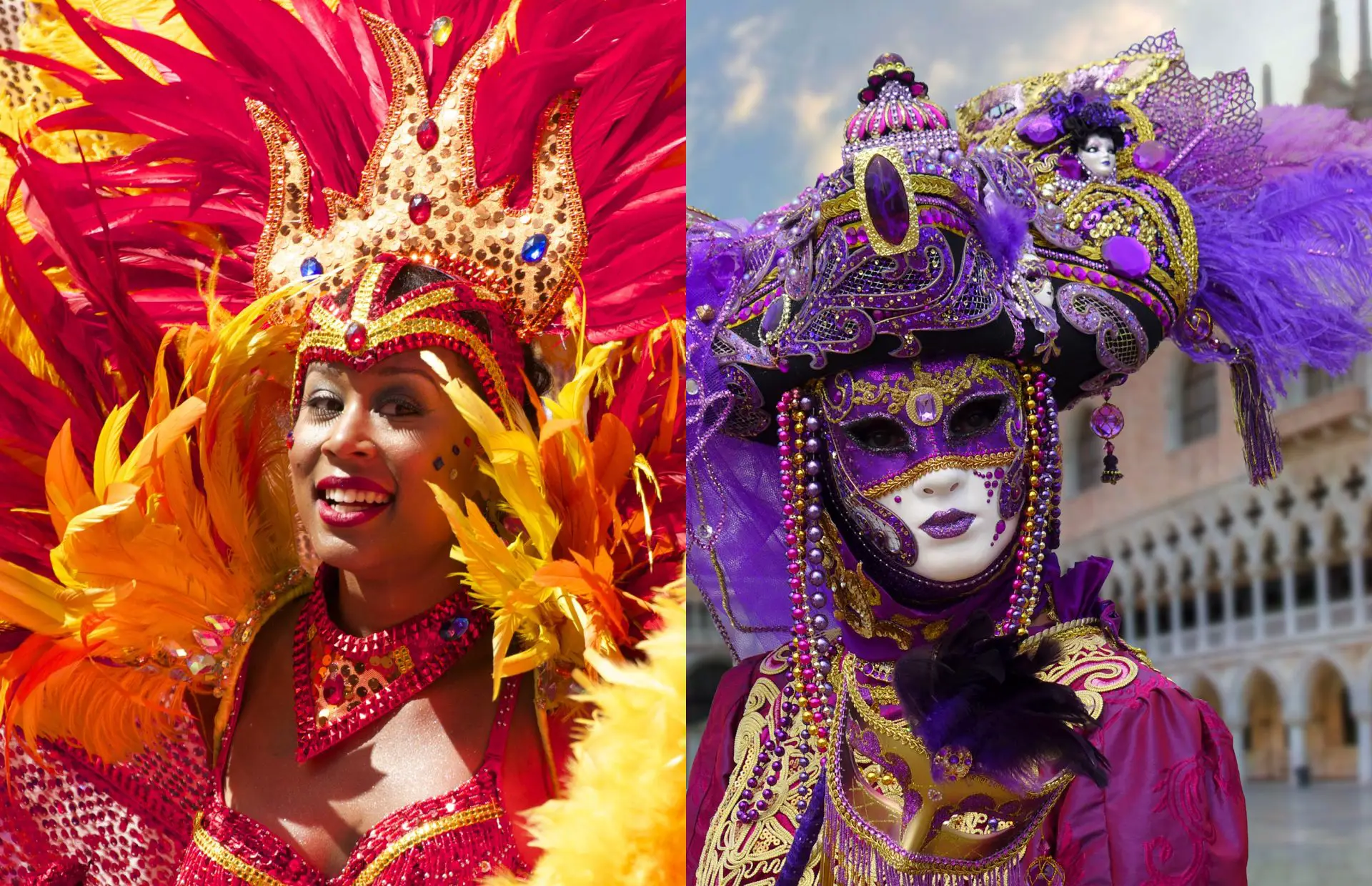10 unique carnival / masquerade traditions around the world
Lent is coming up quickly, and with it the colorful Carnival celebrations around the world.
Also known as Mardi Gras, Fat Tuesday, masquerades, and bacchanals, Carnival is traditionally an indulgent and hedonistic holiday observed before the strict fasting of Lent.
For the most part, celebrations take place after Epiphany or Three Kings Day and last until Ash Wednesday. Mardi Gras (Fat Tuesday in English) refers to the practice of eating fatty foods before fasting for Lent.
Some other names for Mardi Gras include Pancake Day (Ireland), Shrove Tuesday (England), Veilchendienstag or Violet Day for the festive costumes (Germany), Dia de la Tortilla or omelette day (Spain), and even Мaсленица or Butter Week (Russia).
Venice


The lagooned city has one of the most distinctive Carnival celebrations in Europe: the masquerade. Revelers in ballgowns and tricorne hats take to the streets in a party that lasts two weeks and attracts over 3 million attendees.
Venetian masks were a political rebellion against social classes, and the masquerades have a long tradition, with certain shapes and designs representing certain classic characters in the commedia dell’arte tradition of Italian folk theater.
New Orleans

Mardi Gras in New Orleans is popularly known as one of the most debauched celebrations in the traditionally Puritanical United States. The parades and masquerade balls are organized by krewes, social clubs that date back hundreds of years in New Orleans. Any person who rides on a Mardi Gras parade float (other than celebrities or krewe “royalty”) is required by law to disguise their face.
Another custom besides bead-throwing and parades is sharing King Cake in the colors of justice (purple), faith (green), and power (gold). Over 500,000 King Cakes are sold during the Mardi Gras season in New Orleans.
Rio
Feathers, parades, and of course, samba for days. Rio de Janeiro’s Carnival is the most famous and most widely attended in the world.
The first Carnival in Rio started in 1723, and today it is held to celebrate the gods and honor the the great waters.
Over 200 samba schools, or communities who decide to attend Carnival together, parade the street with colorful floats, dancing, and decorations.
Trinidad

Port of Spain, Trinidad hosts the second largest Carnival in the world after Rio. Performers and dancers prepare their costume all year for the celebration, with giant feather headdresses and sequins.
The main attraction is the music and dancing, with Soca music being traditionally featured, as well as music from cultures around the world, including Calypso, chutney, steelpan, claves, and drums. Parties and music competitions called fêtes are hosted for several days before the Carnival itself.
Barbados

No list would be complete without the Crop Over festival of Barbados, famously attended by Rihanna. Unlike most of the Carnivals listed here which happen before Lent, Crop Over festival happens in late summer, traditionally celebrated after the sugarcane harvest, and ends on the first Monday of August on Kadooment Day.
London

London’s Caribbean Notting Hill neighborhood hosts a Carnival as well in August, which I wrote about a little bit in my Portobello Road Market post. The Notting Hill Carnival is rooted in the Caribbean carnival traditions, with roots in Jamaican, Trinidadian, and other West Indian cultures.
Bolivia

Bolivia’s Carnaval de Oruro reflects the country’s South American indigenous roots, and is considered one of UNESCO’s Masterpieces of the Oral and Intangible Heritage of Humanity.
The festival originally has indigenous pagan history, and Spanish colonizers later integrated the celebration with the Christian Virgin of the Candelaria.
Native Itu festivals were banned by the Spanish in the 1700s, but the Uru people of Bolivia continued to worship their Andean gods by disguising them as Catholic symbols.
Today the festival is mainly known for the three day and night parade of 48 multicultural groups of dancers and ends with two mystery (or miracle) plays.
Belgium

Goa

The Portuguese brought their Catholic traditions and festivals to their colony of Goa, India, which has morphed into a spectacle that’s a fascinating blend of Hindu and Catholic customs. The Goa Carnival is one of the largest celebrated in Asia.
Angola

Brazilian samba actually takes its roots from Angolan semba, so it’s no surprise that Angola has a lively Carnival celebration of its own in Luanda. The word ‘semba’ itself is from the Quimbundo language and means to invoke the spirits of ancestors or local Gods.
Any other carnivals you have been to? Let me know about them in the comments!
Pin it:
[row][column width=”50%”] [/column][column width=”50%”]
[/column][column width=”50%”] [/column][/row]
[/column][/row]



you have to add Panamá!!
Ooh I wasn’t aware of Panama’s … I will work on adding that! Thank you!
Trés prestigieux carnaval en Guadeloupe
I would love to see it one day!